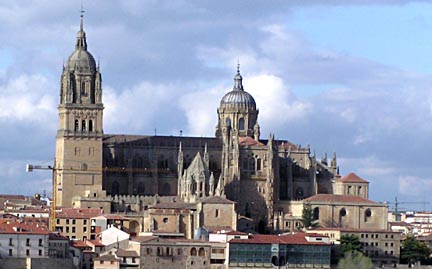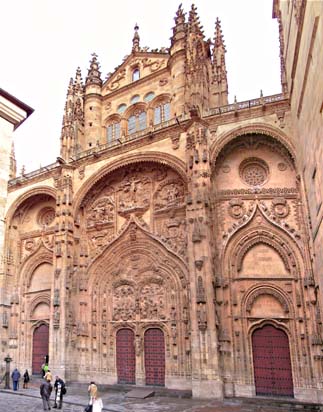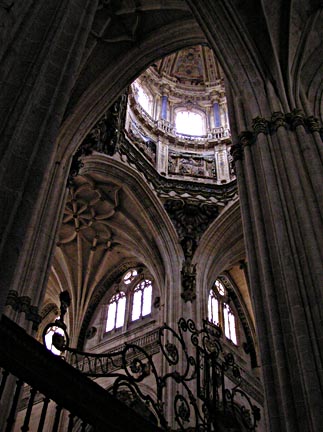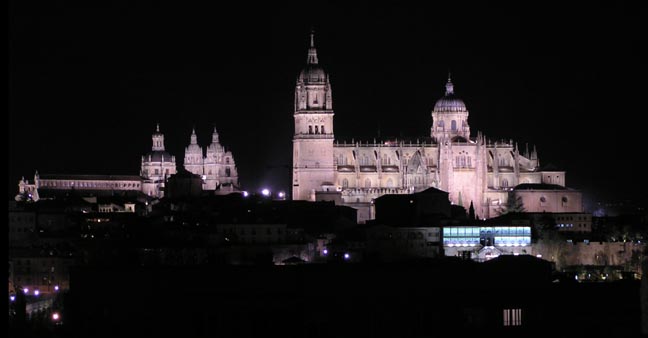|
 We visited Salamanca in April, 2005 on our way back to Germany after a winter in southern Spain. Our neighbors, Antonio and Anita suggested a visit to this city, and so we came. We found a University city, full of classic old buildings made of golden sandstone. Architecturally, Salamanca remains one of Spain’s great cities as it is a showcase of the Spanish Renaissance. We visited Salamanca in April, 2005 on our way back to Germany after a winter in southern Spain. Our neighbors, Antonio and Anita suggested a visit to this city, and so we came. We found a University city, full of classic old buildings made of golden sandstone. Architecturally, Salamanca remains one of Spain’s great cities as it is a showcase of the Spanish Renaissance.
 The photo above is of the new and old cathedrals (yes, they are connected), one of the main features of the Salamanca skyline. The old cathedral (the tower on the left) was built in the late 12th century. The new cathedral was added onto the old in the 16th century. However, much of the new cathedral as well as the bell tower of the old needed extensive rebuilding after the Lisbon earthquake of 1755. The most striking feature of the old cathedral is the west facade which is an amazing tableau of carved sandstone (photo, left). In the afternoon sunlight, it gives off a warm, golden glow. We were amazed at the intricacy and amount of carvings in this one wall. The photo above is of the new and old cathedrals (yes, they are connected), one of the main features of the Salamanca skyline. The old cathedral (the tower on the left) was built in the late 12th century. The new cathedral was added onto the old in the 16th century. However, much of the new cathedral as well as the bell tower of the old needed extensive rebuilding after the Lisbon earthquake of 1755. The most striking feature of the old cathedral is the west facade which is an amazing tableau of carved sandstone (photo, left). In the afternoon sunlight, it gives off a warm, golden glow. We were amazed at the intricacy and amount of carvings in this one wall.
 Inside the cathedral, the great pillars supporting the arches and the central dome force your eye upward (photo at right). The central dome (part of the new cathedral) is a beautifully light and delicately colored piece of work which seems to have had some Byzantine influence. Inside the cathedral, the great pillars supporting the arches and the central dome force your eye upward (photo at right). The central dome (part of the new cathedral) is a beautifully light and delicately colored piece of work which seems to have had some Byzantine influence.
The highly Baroque choir stalls seem almost alive with cherubs and saints, while the altarpiece is a beautiful compilation of 53 scenes from the lives of Christ and the Virgin. Our favorite was the organ (currently undergoing restoration), adorned with playful cherubs. It is one of the oldest in Europe.
The north entrance leads out to the Plaza Anaya where there is another elaborate facade with intricate carvings around the doorways (though less so than the west entrance). Here, when recent restoration was undertaken, some more progressive adornments were added, such as the carving of the astronaut.
Near the cathedrals are many university buildings, also built in sandstone, with lovely squares to relax in. However, the most impressive of the squares is the Plaza Mayor (above), a huge square completely surrounded by elegant sandstone buildings and covered walkway perimeter, full of shops and restaurants. The square was designed by Alberto Churriguera and built between 1729 and 1755. It was used for bull fights into the 19th century and is now the main meeting place for the city. It is considered one of the most engaging squares in all of Spain.
 The city is also full of convents and monasteries, one of the most striking being the Convent of St. Estaban. The photo at left focuses on the western facade of the church containing carved motifs up to a height of 98 feet, the central theme being the stoning of St. Estaban. The monks at this convent were the first to take Coumbus’s ideas seriously and helped him to gain an introduction to Queen Isabella. The city is also full of convents and monasteries, one of the most striking being the Convent of St. Estaban. The photo at left focuses on the western facade of the church containing carved motifs up to a height of 98 feet, the central theme being the stoning of St. Estaban. The monks at this convent were the first to take Coumbus’s ideas seriously and helped him to gain an introduction to Queen Isabella.
The overall sense of Salamanca was peaceful and serene while being busy and full of life. Part of this we think is due to the unifying effect of the sandstone buildings. However, in and around these relics are new, modern buildings and somehow it all seems to work together. Much of the new part of the city is across the Tormes river, which allows the historic portion of the city to remain mostly intact. From our hotel on the other side of the river, we had a great nighttime view of the historic city:
|

 We visited Salamanca in April, 2005 on our way back to Germany after a winter in southern Spain. Our neighbors, Antonio and Anita suggested a visit to this city, and so we came. We found a University city, full of classic old buildings made of golden sandstone. Architecturally, Salamanca remains one of Spain’s great cities as it is a showcase of the Spanish Renaissance.
We visited Salamanca in April, 2005 on our way back to Germany after a winter in southern Spain. Our neighbors, Antonio and Anita suggested a visit to this city, and so we came. We found a University city, full of classic old buildings made of golden sandstone. Architecturally, Salamanca remains one of Spain’s great cities as it is a showcase of the Spanish Renaissance.  The photo above is of the new and old cathedrals (yes, they are connected), one of the main features of the Salamanca skyline. The old cathedral (the tower on the left) was built in the late 12th century. The new cathedral was added onto the old in the 16th century. However, much of the new cathedral as well as the bell tower of the old needed extensive rebuilding after the Lisbon earthquake of 1755. The most striking feature of the old cathedral is the west facade which is an amazing tableau of carved sandstone (photo, left). In the afternoon sunlight, it gives off a warm, golden glow. We were amazed at the intricacy and amount of carvings in this one wall.
The photo above is of the new and old cathedrals (yes, they are connected), one of the main features of the Salamanca skyline. The old cathedral (the tower on the left) was built in the late 12th century. The new cathedral was added onto the old in the 16th century. However, much of the new cathedral as well as the bell tower of the old needed extensive rebuilding after the Lisbon earthquake of 1755. The most striking feature of the old cathedral is the west facade which is an amazing tableau of carved sandstone (photo, left). In the afternoon sunlight, it gives off a warm, golden glow. We were amazed at the intricacy and amount of carvings in this one wall. Inside the cathedral, the great pillars supporting the arches and the central dome force your eye upward (photo at right). The central dome (part of the new cathedral) is a beautifully light and delicately colored piece of work which seems to have had some Byzantine influence.
Inside the cathedral, the great pillars supporting the arches and the central dome force your eye upward (photo at right). The central dome (part of the new cathedral) is a beautifully light and delicately colored piece of work which seems to have had some Byzantine influence. 
 The city is also full of convents and monasteries, one of the most striking being the Convent of St. Estaban. The photo at left focuses on the western facade of the church containing carved motifs up to a height of 98 feet, the central theme being the stoning of St. Estaban. The monks at this convent were the first to take Coumbus’s ideas seriously and helped him to gain an introduction to Queen Isabella.
The city is also full of convents and monasteries, one of the most striking being the Convent of St. Estaban. The photo at left focuses on the western facade of the church containing carved motifs up to a height of 98 feet, the central theme being the stoning of St. Estaban. The monks at this convent were the first to take Coumbus’s ideas seriously and helped him to gain an introduction to Queen Isabella.